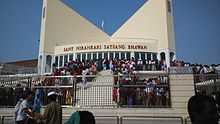Sant Nirankari Mission
 Sant Nirankari Samagam Fair at Nirankari Colony, New Delhi on 16 Nov 2014 Universal Brotherhood | |
| Abbreviation | SNM |
|---|---|
| Motto | Universal Brotherhood |
| Formation | May 1929 |
| Purpose | "Universal Brotherhood" |
| Headquarters |
Nirankari Colony, Delhi - 110 009. India. |
Main organ | Sant Nirankari Mandal |
| Website | nirankari.org |
The Sant Nirankari Mission (Punjabi: ਸੰਤ ਨਿਰੰਕਾਰੀ ਮਿਸ਼ਨ, Hindi: संत निरंकारी मिशन, SNM) and also known as Universal Brotherhood Mission, is a spiritual organisation based in India. The Sant Nirankari Mission identifies itself as "neither a new religion nor a sect of an existing religion, but an all-embracing spiritual movement dedicated to human welfare".[SNM 1]
Despite the similarity of name, the group is not[1] (or is no longer[2]) affiliated with the Nirankari movement started by Baba Dayal. The Sant Nirankari movement has been targeted for violence by some extremists among the orthodox Sikhs, who consider the group to be a heresy of Sikhism.[3]
The SNM has over 100 branches outside India, most prominently in Britain and North America. Its world headquarters is located in Sant Nirankari Colony, New Delhi.[SNM 2] Its leader, Baba Hardev Singh, provides spiritual guidance for Nirankari devotees; as well as for whole mankind follows any religion, caste and culture. The group is characterised by its focus on a living leader.[4]
History
The original Nirankari movement began with the reformist teachings of Baba Buta Singh in the early 19th century. Baba Buta Singh emphasised the importance of a living guru, while mainstream Sikhism accepted the Sikh scriptures as the final, and current, guru of the faith. This would eventually cause a distinction between mainstream Sikhism and the Sant Nirankari movement. In 1929, one segment of the movement, now known as the Sant Nirankari Mission, disassociated itself from mainstream Sikhism and became an independent organisation.[5]
In the 1960s, the sudden growth of the Sant Nirankari Mission aroused the ire of fundamentalist Sikhs, some of whom used opposition to the Sant Nirankaris as a platform.[6] The Sant Nirankari Satguru Gurbachan Singh was assassinated in 1980, by a Ranjit Singh, a member of the Akhand Kirtani Jatha. The AKJ had, shortly before the killing, had been involved in protests against the Sant Nirankaris as heterodox.[7]
Avtar Bani
The Avtar Bani outlines the key philosophy of the Sant Nirankari Mission, and serves as the group's primary text, though not necessarily a holy book. It is named after its author Shahenshan Baba Avtar Singh.[SNM 3] Its initial version was first published in 1957. Its successor, the Sampuran Avtar Bani ("complete Avtar Bani") was published in 1965. The Avtar Bani was originally written in Punjabi verse, but some stanzas were in the Urdu and Sindhi language. It contains 376 hymns which describe the qualities of Formless God (Nirankar), the important role of a spiritual in attaining God-realisation, the kindness and grace of the "True Master", the purpose of human life, the five fundamental principles, true devotion and how a man can lead a saintly life. It has been published in Gurumukhi, Devnagari, Urdu and Roman scripts. It has also been translated and published in English (verse and prose), Hindi, Bengali, Gujarati, Tamil, Telugu, Nepali and Marathi verse.
Nirankari Museum
The Nirakari Museum was officially launched by Baba Hardev Singh on 22 February 2005. The museum is located within the Sant Nirankari Sarovar in North Delhi, and depicts the history of the Nirankari Mission through audio-visuals and pictures.[8][9]
Nirankari International Samagam
The first Nirankari International Samagam (NIS) was held on 11-12 August 2012 at National Indoor Arena in Birmingham, United Kingdom. The theme of the samagam was Oneness.
Notes and references
- ↑ Sardar Harjeet Singh (2009). Faith & Philosophy of Sikhism. Gyan Publishing House. pp. 144–. ISBN 978-81-7835-721-8. Retrieved 12 April 2012.
- ↑ W. H. McLeod (28 July 2005). Historical dictionary of Sikhism. Scarecrow Press. pp. 180–. ISBN 978-0-8108-5088-0. Retrieved 12 April 2012.
- ↑ William Gould (31 October 2011). Religion and Conflict in Modern South Asia. Cambridge University Press. pp. 237–. ISBN 978-0-521-70511-0. Retrieved 12 April 2012.
- ↑ Knott, Kim (1998). "The Religions of South Asian Communities in Britain". In Hinnells, John R. A new handbook of living religions (2nd ed.). Cambridge, Mass: Penguin Books Canada Ltd. pp. 756–774. ISBN 0-14-051407-4. OCLC 317517572.
- ↑ Padma Rangaswamy (30 December 2007). Namaste America. Penn State Press. pp. 269–. ISBN 978-0-271-02775-3. Retrieved 12 April 2012.
- ↑ Martin E. Marty (1 July 1996). Fundamentalisms and the State: Remaking Polities, Economies, and Militance. University of Chicago Press. pp. 273–. ISBN 978-0-226-50884-9. Retrieved 12 April 2012.
- ↑ "Punjab: The Knights of Falsehood – Psalms of Terror". South Asia Terrorism Portal. New Delhi: Institute for Conflict Management. 31 December 2001. Retrieved 13 December 2010.
- ↑ "Our Staff Reporter" (23 February 2005). "Nirankari Museum inaugurated". The Hindu (Chennai, Madras, India: Kasturi and Sons Ltd). OCLC 35304678. Retrieved 11 December 2010.
- ↑ Tribune News Service (24 February 2005). "A museum of spiritual panorama". The Tribune, Chandigarh, India (Chandigarh, Indi: The Tribune Trust). OCLC 47351219. Retrieved 11 December 2010.
- McKean, Lise (1996). Divine enterprise: Gurus and the Hindu Nationalist Movement. Chicago: University of Chicago Press. p. 273. ISBN 0-226-56009-0. OCLC 32859823. Retrieved 18 December 2010.
- Dr Harjinder Singh Dilgeer. Sikh History in 10 volumes. Singh Brothers, Amritsar, 2011. Vol. 7
- Dr Harjinder Singh Dilgeer. Sikh Twareekh. Singh Brothers, Amritsar, 2008. Vol 3.(Punjabi)
References from Sant Nirankari Mandal website
- ↑ "History | Baba Buta Singh Ji (1873–1943)". Sant Nirankari Mission. Delhi, India: Sant Nirankari Mandal (Regd.). Retrieved 10 December 2010.
- ↑ "Souvenir 50th Samagam – Organisational Outfit of Sant Nirankari Mission". Sant Nirankari Mission. Delhi, India: Sant Nirankari Mandal (Regd.). Retrieved 10 December 2010.
- ↑ "SNM History – Baba Avtar Singh Ji". Sant Nirankari Mission. Delhi, India: Sant Nirankari Mandal (Regd.). Retrieved 11 December 2010.